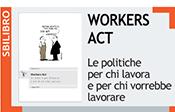Ultimi link in questa sezione
Come Wall Street ha occupato l'America
During the prairie revolt that swept the Great Plains in 1890, populist orator Mary Elizabeth Lease exclaimed, “Wall Street owns the country…. Money rules…. Our laws are the output of a system which clothes rascals in robes and honesty in rags. The [political] parties lie to us and the political speakers mislead us.”
She should see us now. John Boehner calls on the bankers, holds out his cup and offers them total obeisance from the House majority if only they fill it. Barack Obama criticizes bankers as “fat cats,” then invites them to dine at a pricey New York restaurant where the tasting menu runs to $195 a person.
That’s now the norm, and they get away with it. The president has raised more money from employees of banks, hedge funds and private equity managers than any Republican candidate, including Mitt Romney. Inch by inch he has conceded ground to them while espousing populist rhetoric that his very actions betray.
Let’s name this for what it is: hypocrisy made worse, the further perversion of democracy. Our politicians are little more than money launderers in the trafficking of power and policy—fewer than six degrees of separation from the spirit and tactics of Tony Soprano.
Why New York’s Zuccotti Park is filled with people is no mystery. Reporters keep scratching their heads and asking, “Why are you here?” But it’s clear they are occupying Wall Street because Wall Street has occupied the country. And that’s why in public places across the nation workaday Americans are standing up in solidarity. Did you see the sign a woman was carrying at a fraternal march in Iowa the other day? It read, I Can’t Afford to Buy a Politician So I Bought This Sign. Americans have learned the hard way that when rich organizations and wealthy individuals shower Washington with millions in campaign contributions, they get what they want.
In his Pulitzer Prize–winning book The Radicalism of the American Revolution, historian Gordon Wood says that our nation discovered its greatness “by creating a prosperous free society belonging to obscure people with their workaday concerns and pecuniary pursuits of happiness.” This democracy, he said, changed the lives of “hitherto neglected and despised masses of common laboring people.”
Those words moved me when I read them. They moved me because Henry and Ruby Moyers were “common laboring people.” My father dropped out of the fourth grade and never returned to school because his family needed him to pick cotton to help make ends meet. Mother managed to finish the eighth grade before she followed him into the fields. They were tenant farmers when the Great Depression knocked them down and almost out. The year I was born my father was making $2 a day working on the highway to Oklahoma City. He never took home more than $100 a week in his working life, and he made that only when he joined the union in the last job he held. I was one of the poorest white kids in town, but in many respects I was the equal of my friend who was the daughter of the richest man in town. I went to good public schools, had the use of a good public library, played sandlot baseball in a good public park and traveled far on good public roads with good public facilities to a good public university. Because these public goods were there for us, I never thought of myself as poor. When I began to piece the story together years later, I came to realize that people like the Moyerses had been included in the American deal. “We, the People” included us.
* * *
It’s heartbreaking to see what has become of that bargain. Nowadays it’s every man for himself. How did this happen? The rise of the money power in our time goes back forty years. We can pinpoint the date. On August 23, 1971, a corporate lawyer named Lewis Powell—a board member of the death-dealing tobacco giant Philip Morris and a future justice of the Supreme Court—released a confidential memorandum for his friends at the US Chamber of Commerce. We look back on it now as a call to arms for class war waged from the top down.
Recall the context of Powell’s memo. Big business was being forced to clean up its act. Even Republicans had signed on. In 1970 President Nixon put his signature on the National Environmental Policy Act and named a White House Council to promote environmental quality. A few months later millions of Americans turned out for Earth Day. Nixon then agreed to create the Environmental Protection Agency. Congress acted swiftly to pass tough amendments to the Clean Air Act, and the EPA announced the first air pollution standards. There were new regulations directed at lead paint and pesticides. Corporations were no longer getting away with murder.
Powell was shocked by what he called an “attack on the American free enterprise system.” Not just from a few “extremists of the left” but also from “perfectly respectable elements of society,” including the media, politicians and leading intellectuals. Fight back and fight back hard, he urged his compatriots. Build a movement. Set speakers loose across the country. Take on prominent institutions of public opinion—especially the universities, the media and the courts. Keep television programs “monitored the same way textbooks should be kept under constant surveillance.” And above all, recognize that political power must be “assiduously [sic] cultivated; and that when necessary, it must be used aggressively and with determination” and “without embarrassment.”
Powell imagined the Chamber of Commerce as a council of war. Since business executives had “little stomach for hard-nosed contest with their critics” and “little skill in effective intellectual and philosophical debate,” they should create think tanks, legal foundations and front groups of every stripe. These groups could, he said, be aligned into a united front through “careful long-range planning and implementation…consistency of action over an indefinite period of years, in the scale of financing available only through joint effort, and in the political power available only through united action and united organizations.”
The public wouldn’t learn of the memo until after Nixon appointed Powell to the Supreme Court that same year, 1971. By then his document had circulated widely in corporate suites. Within two years the board of the Chamber of Commerce had formed a task force of forty business executives—from US Steel, GE, GM, Phillips Petroleum, 3M, Amway, and ABC and CBS (two media companies, we should note). Their assignment was to coordinate the crusade, put Powell’s recommendations into effect and push the corporate agenda. Powell had set in motion a revolt of the rich. As historian Kim Phillips-Fein subsequently wrote, “Many who read the memo cited it afterward as inspiration for their political choices.”
They chose swiftly. The National Association of Manufacturers announced that it was moving its main offices to Washington. In 1971 only 175 firms had registered lobbyists in the capital; by 1982 nearly 2,500 did. Corporate PACs increased from fewer than 300 in 1976 to more than 1,200 by the mid-’80s. From Powell’s impetus came the Business Roundtable, the American Legislative Exchange Council (ALEC), the Heritage Foundation, the Cato Institute, the Manhattan Institute, Citizens for a Sound Economy (precursor to what we now know as Americans for Prosperity) and other organizations united in pushing back against political equality and shared prosperity. They triggered an economic transformation that would in time touch every aspect of our lives.
The Chamber of Commerce, in response to the memo, doubled its membership, tripled its budget and stepped up its lobbying efforts. It’s going stronger than ever. Most recently, it called in its agents in Congress to kill a bill to provide healthcare to 9/11 first responders for illnesses linked to their duty on that day. The bill would have paid for their medical care by ending a special tax loophole exploited by foreign corporations with business interests in America. The Chamber, along with nearly 1,300 business and trade groups, urged Congress to pass the new tax bill, signed into law just before this past Christmas and filled with all kinds of stocking stuffers, including about fifty tax breaks for businesses. The bill gave some of our biggest banks, financial companies and insurance firms another year’s exemption to shield their foreign profits from being taxed here in the United States; among the beneficiaries were giants Citigroup, Bank of America, Goldman Sachs and Morgan Stanley, all of which survived the financial debacle of their own making because taxpayers bailed them out in 2008.
The coalition got another powerful jolt of adrenaline in the late ’70s from the wealthy right-winger who had served as Nixon’s treasury secretary, William Simon. His book A Time for Truth argued that “funds generated by business” must “rush by multimillions” into conservative causes to uproot the institutions and the “heretical strategy” of the New Deal. He called on “men of action in the capitalist world” to mount “a veritable crusade” against progressive America. BusinessWeek (October 12, 1974) somberly explained that “it will be a bitter pill for many Americans to swallow the idea of doing with less so that big business can have more.”
Those “men of action in the capitalist world” were not content with their wealth just to buy more homes, more cars, more planes, more vacations and more gizmos than anyone else. They were determined to buy more democracy than anyone else. And they succeeded beyond their expectations. After their forty-year “veritable crusade” against our institutions, laws and regulations—against the ideas, norms and beliefs that helped to create America’s iconic middle class—the Gilded Age is back with a vengeance.










